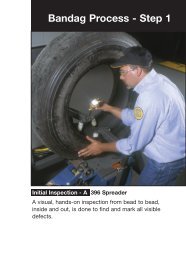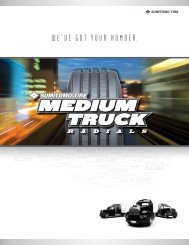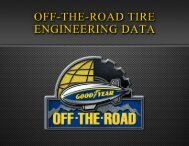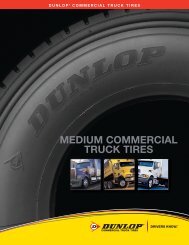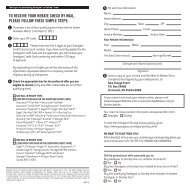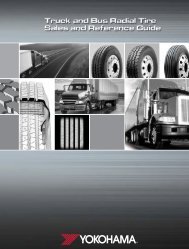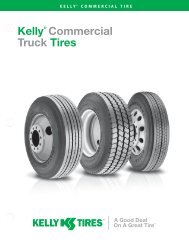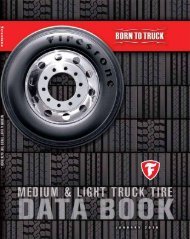Bridgestone Medium and Light Truck Tire Data Book - Sullivan Tire ...
Bridgestone Medium and Light Truck Tire Data Book - Sullivan Tire ...
Bridgestone Medium and Light Truck Tire Data Book - Sullivan Tire ...
You also want an ePaper? Increase the reach of your titles
YUMPU automatically turns print PDFs into web optimized ePapers that Google loves.
Effective January 2010<br />
General Technical Information<br />
W. Repair <strong>and</strong> Retreading<br />
Improperly repaired or retreaded truck tires may<br />
cause sudden tire destruction.<br />
<strong>Bridgestone</strong> truck tires should only be retreaded <strong>and</strong><br />
repaired by trained personnel.<br />
An inspection of each tire should be done before<br />
operating the vehicle. Damaged tires should be<br />
inspected by an authorized <strong>Bridgestone</strong> tire dealer.<br />
A puncture left unrepaired may result in further<br />
internal casing damage <strong>and</strong> eventual tire destruction.<br />
Never use plug-only repairs on <strong>Bridgestone</strong> truck<br />
tires. An interior patch with plug or other approved<br />
material is required. Nail hole repairs should be made<br />
only after demounting <strong>and</strong> inspecting the interior of<br />
the tire.<br />
Never use a tube as a substitute for a proper<br />
tire repair.<br />
Belt Removal<br />
1. The removal of the fourth (outer) belt is<br />
permissible. This belt may be omitted<br />
when retreading.<br />
2. The removal of the third belt is more involved. If it<br />
is essential that the third belt be removed, then it<br />
must be replaced before retreading.<br />
A New Perspective<br />
Anything you do to save fuel will<br />
improve your profitability – if it<br />
doesn’t cost more than it saves.<br />
<strong>Bridgestone</strong> B<strong>and</strong>ag <strong>Tire</strong> Solutions<br />
(BBTS) has been studying the<br />
relationship of tires to fuel economy<br />
for over a quarter of a century. What<br />
follows summarizes that research.<br />
For a detailed look at truck tire<br />
fuel economy, ask your BBTS<br />
representative for a copy of <strong>Tire</strong>s<br />
& <strong>Truck</strong> Fuel Economy, a Real<br />
Answers magazine “Special<br />
Edition.” You may also view this<br />
publication online or order copies<br />
by visiting <strong>Bridgestone</strong><strong>Truck</strong>tires.com.<br />
X. Y. Large <strong>Truck</strong> Fuel Economy<br />
3. A nail hole repair of 3/8" or less in diameter may<br />
be made in the crown area of either radial or bias<br />
tires. A section repair in a radial is required to<br />
repair any injury larger than a 3/8" nail hole.<br />
4. Bias section repairs are made when the injury<br />
is either larger than 1-1/4" in diameter, is not<br />
perfectly round or perpendicular to the liner<br />
surface, or when the injury is larger than 3/8"<br />
in diameter <strong>and</strong> combination patch plugs are<br />
not used.<br />
Today’s trucks have an estimated<br />
engine efficiency of approximately<br />
40 percent. Therefore, only about<br />
40 percent of the energy converted<br />
from diesel fuel reaches the axles.<br />
Some things influence use of this<br />
40 percent of available energy<br />
more than others. We’ll take them<br />
in order, starting with some of<br />
the largest.<br />
<strong>Medium</strong> <strong>Truck</strong> <strong>Light</strong> <strong>Truck</strong> General Technical Load/Inflation Technical Bulletins<br />
83



